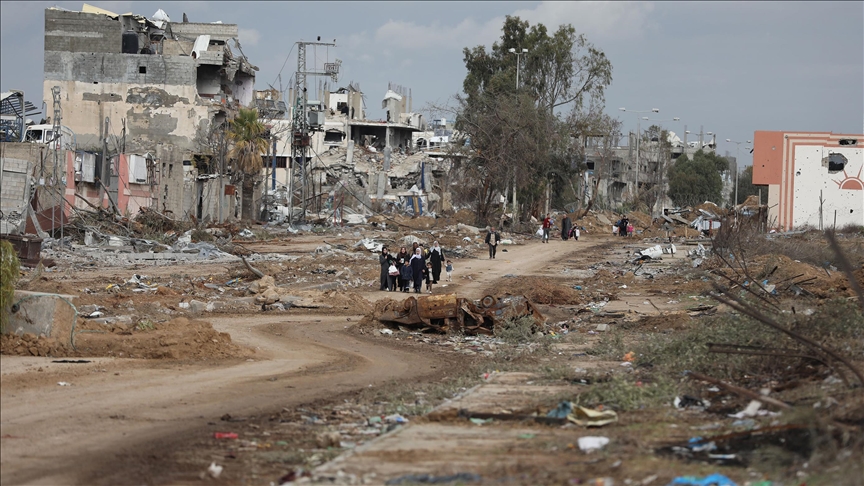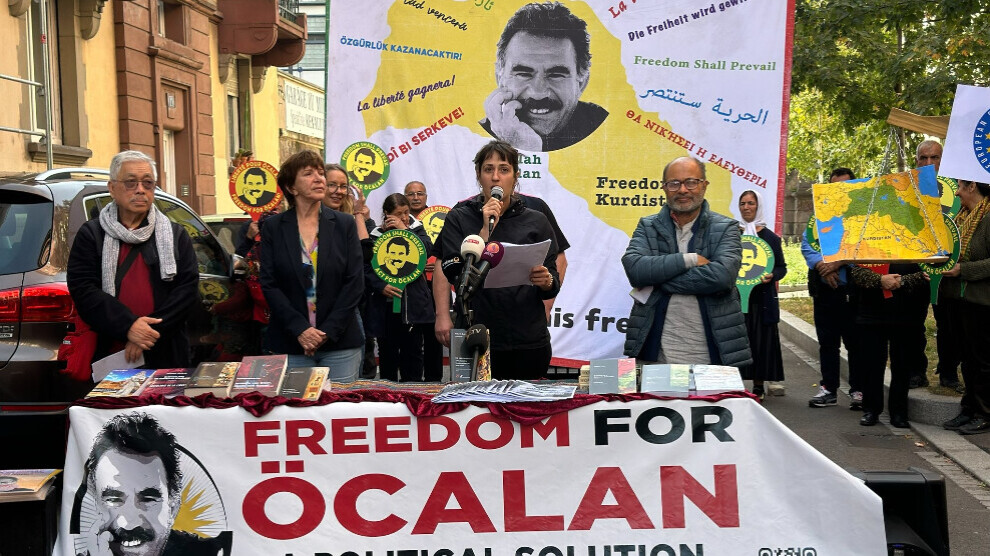Jake Johnson, Common Dreams
November 28, 2023

Israeli Prime Minister Benjamin Netanyahu
With his approval ratings in the tank, Israeli Prime Minister Benjamin Netanyahu has reportedly been lobbying members of his Likud party in a bid to keep their support, claiming he is "the only one who will prevent a Palestinian state" in Gaza and the West Bank.
Netanyahu's remarks, first reported by the Israeli public broadcaster Kan, fly in the face of the Biden administration's continued push for a two-state solution as the "only way to guarantee the long-term security of both the Israeli and the Palestinian people."
"To make sure Israelis and Palestinians alike live in equal measure of freedom and dignity, we will not give up on working towards that goal," U.S. President Joe Biden, who has offered unconditional political and military support to Israel during its latest assault on Gaza, wrote in a social media post late Monday.
Analysts have long argued that one democratic state, not two states, is the only viable alternative to the apartheid status quo, given factors such as ever-expanding Israeli settlements in the West Bank. Throughout his career, Netanyahu has vociferously opposed a peaceful resolution and worked to divide Palestinians in Gaza and the West Bank by propping up Hamas.
"Anyone who wants to thwart the establishment of a Palestinian state has to support bolstering Hamas and transferring money to Hamas," Netanyahu told his colleagues in 2019. "This is part of our strategy—to isolate the Palestinians in Gaza from the Palestinians in the West Bank."
In his latest comments to Likud backbenchers, Netanyahu reportedly said he's "the only one who can withstand U.S. pressure" and that he knows "how to manage American public opinion," even as American public support for Israel's assault on Gaza falls
The Times of Israelreported Monday that Netanyahu "boasted about having gone against" U.S. wishes by launching a ground invasion of Gaza and raiding the Palestinian territory's largest hospital on the pretense that Hamas was hiding a command center on the facility's grounds—a claim that has not been substantiated.
Netanyahu, facing mounting domestic pressure to resign, has also indicated that Israel plans to occupy the Gaza Strip for an "indefinite period" after the current war, defying Biden's warning against a prolonged occupation.
"Look Joe Biden: Netanyahu is spitting in your face," Yonah Lieberman, co-founder of the Jewish-American advocacy group IfNotNow, wrote on social media Monday. "He doesn't take you seriously. Are you going to keep hugging him in public or are you going to finally end the blank check and hold him accountable for his words and actions?"
News of the Israeli prime minister's meetings with Likud lawmakers came as the attack on Gaza is under a tenuous pause to allow for the release of hostages. Netanyahu has opposed a lasting cease-fire and pledged to continue waging war on the strip once the pause is over.
The Financial Times reported Tuesday that Biden and other top U.S. officials have implored Israel not to trigger mass internal displacement in its planned offensive in southern Gaza, where many people have fled to escape Israeli bombing in the north. Israel's assault has displaced around 70% of Gaza's population so far.
Israeli officials have not provided any public indication that their bombing campaign will be less destructive following the end of the pause.
"The enemy will meet first the bombs of the Air Force, and after that the shells of the tanks and the artillery and the scoops of the D9 [bulldozers], and finally gunfire of the infantry troops," Israeli Defense Minister Yoav Gallant said Monday. "We will fight in the entire strip."
All parties should use humanitarian pause 'to work toward full cease-fire, on human rights and humanitarian grounds,' spokeswoman tells Anadolu
Beyza Binnur Donmez |28.11.2023 - AA

GENEVA
Recent comments from Israeli political and leadership that they plan to expand the military offensive in Gaza at the end of the humanitarian pause are “deeply worrying,” the UN human rights office said on Tuesday.
“The comments of Israeli political and military leadership in recent days that they plan to expand and intensify the military offensive across Gaza following the pause are deeply worrying.” Marta Hurtado, spokesperson for the Office of the UN High Commissioner for Human Rights, told Anadolu.
She urged all parties of the conflict as well as states with influence to use the current humanitarian pause "to work towards a full cease-fire, on human rights and humanitarian grounds."
Nothing that there has been an "important respite" from the "hellfire" of the past seven weeks for civilians in Gaza, and some families have been reunited with loved ones, Hurtado said: "Much more must be done."
"The protection of civilians must be the top priority," she added.
She stressed that in order to ensure that aid meets the needs of the civilian population, the humanitarian space must be improved - “including through the opening of a crossing from Israel.”
Israeli officials have said that at the end of the humanitarian pause in Gaza, now in its fifth day and set to go on for a sixth, the army would resume its military offensive on the enclave.
Qatar announced an agreement late Monday to extend the initial four-day humanitarian pause for an additional two days, under which further prisoner exchanges will be carried out.
Israel launched a massive military campaign in the Gaza Strip following a cross-border attack by Hamas on Oct. 7.
It has since killed over 15,000 people, including 6,150 children and 4,000 women, according to health authorities in the enclave.
The official Israeli death toll stands at 1,200.
Dr Ghassan Abu Sitta, a veteran war surgeon, says that Israel's sustained attacks on Gaza aim to make the region "uninhabitable", as he returns to the UK to testify on alleged war crimes.

"My duty as a doctor is not just to give treatment to my patients, but also to find justice for them," says Dr Abu Sitta.
Weeks of unrelenting attacks by Israel are part of an attempt to "ethnically cleanse" the besieged Gaza by making it uninhabitable, according to British-Palestinian surgeon Dr Ghassan Abu Sitta.
Abu Sitta, an experienced war surgeon, has just returned to the UK after weeks of caring for the wounded and sick in Gaza, including at the Al Ahli Baptist Hospital and the Al Shifa Medical Complex, as the Palestinian enclave was pummeled by over 40,000 tonnes of Israeli explosives.
Returning to Britain to provide a first-hand account of what has been happening in Gaza from inside the hospitals, Abu Sitta has agreed to work with UK police to provide eyewitness evidence of Israeli "war crimes" perpetrated over the past few weeks.
"My duty as a doctor is not just to give treatment to my patients, but also to find justice for them," he told Anadolu in London after giving a news conference organised by the International Centre of Justice for Palestinians.

'Situation in Gaza remains catastrophic'
Abu Sitta, who has over 30 years of experience, has worked on 12 wars across Yemen, Iraq, Syria, South Lebanon, and Gaza. He arrived in the Palestinian enclave following Israel's war in Gaza.
Shortly thereafter, he said British counterterrorism police "showed up at my house in the UK and harassed my family."
However, he said he would not "stop speaking out on behalf of my patients and bearing witness to the crimes that are being committed."
On the current situation across Gaza, where a humanitarian pause has been in place since Friday, he said that while some food and medicine have made it into the enclave after a devastating blockade, this was "not enough."
"The situation in Gaza still remains catastrophic. There are shortages of food and water and medication," Abu Sitta stressed, noting that out of 36 hospitals, only nine of them have survived the Israeli attacks.
'Hospital full of wounded with no anaesthetic medication'
Israel aims to "clear Gaza of its population," Abu Sitta asserted, adding that Tel Aviv sought "to ethnically cleanse Gaza to make it unlivable."
"If you want to make a place uninhabitable, you do two things: You injure 37,000 people, and then you destroy the health system so that they can never find treatment, which means that their families have to take them out of Gaza for their treatment, which means that you create an uninhabitable Gaza," he explained.
Recounting one of his worst experiences in the course of the several weeks he was there, Abu Sitta talked about an incident that took place after Israel targeted a mosque during nighttime prayers, just two days before he had to leave Al Ahli Baptist Hospital.
"They killed 60 people and hundreds were brought in wounded," he said, adding that they only had two operating rooms left but continued to operate on injured patients until they ran out of medication.
At that point, they had to leave the hospital, even though there were still 500 wounded after finishing "with all of the anaesthetic medication." Al Ahli was the only hospital left in the northern part of Gaza at the time.
"The hospital was full of wounded, everywhere on the floor, on the grounds, and all of them still needed more surgery, but there were just no operating rooms left."
On a possible worst-case scenario for Gaza, if the attacks continue, Abu Sitta said this would be a return to total blockade of the strip following the current pause, with no materials allowed inside to rebuild homes and bring hospitals back into operation.
"So, the war will continue as a silent death to make sure that Gaza becomes uninhabitable."
















